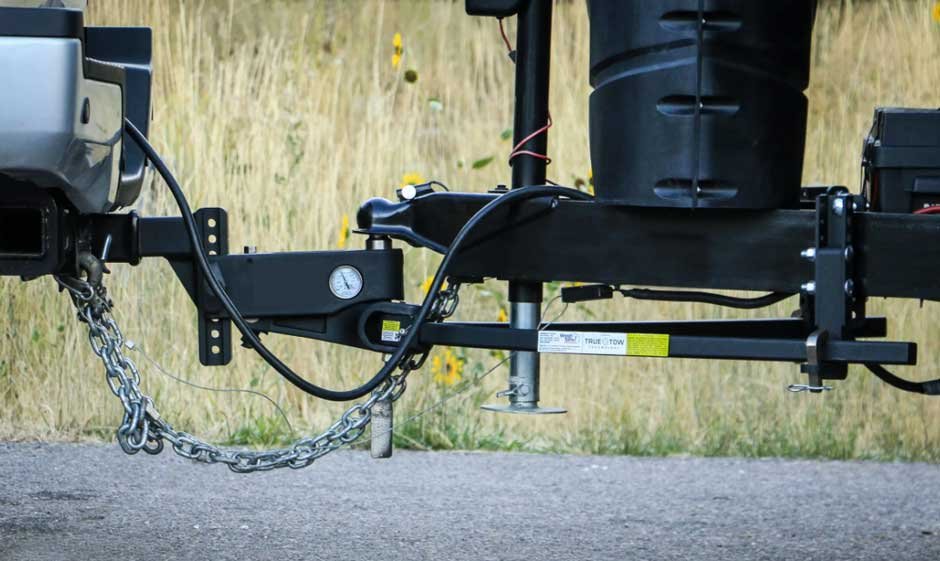What is a Weight Distribution Hitch?
A weight distribution hitch is a crucial towing accessory that distributes the weight of a trailer evenly across the vehicle’s axles. The vehicle’s rear may trailer without traction, increasing accident risks. A weight distribution hitch enhances stability and safety, especially when towing heavy loads.
Why Use a Weight Distribution Hitch?
Using a weight distribution hitch with sway control offers several benefits. A weight distribution system prevents trailer sway, a dangerous issue in towing, and can reduce rear-end sag and enhance driving stability. This system evenly distributes weight across the vehicle and trailer axles, reducing wear and tear on the vehicle. This results in a smoother ride, safer driving, and better fuel efficiency.
How Weight Distribution Hitches Work
Weight distribution hitches distribute the weight from the trailer tongue to the trailer and vehicle axles, reducing rear-end sag and improving stability. This balanced distribution minimizes rear-end sag and enhances steering control and braking performance. Reducing trailer sway makes highway driving less stressful and safer, as the front wheels maintain better contact with the road surface.
Types of Weight Distribution Hitches
Weight distribution hitches come in a variety of forms, each with unique benefits and applications for various towing requirements:
- Spring Bar Hitchesare the most prevalent; distributors employ adjusted vehicle bars. They offer a fit adaptable to various towing configurations, enabling modifications to guarantee the ideal balance. This kind is very versatile and helpful for multiple trailer weights and sizes.
- Chain-Style Hitches:These feature chains connect the spring bars, offering flexibility in adjustment but can be more cumbersome to install. The chains allow for incremental adjustments of the spring bars, which can be beneficial for fine-tuning the towing setup, although they might require more time and effort to set up each time.
- Trunnion Bar Hitches:Known for their durability, trunnion bar hitches use square bars that slide into brackets mounted on the trailer tongue. This design typically offers higher weight capacity and easier installation than chain-style hitches. Due to their sturdiness and ease of handling, they are preferable for heavier trailers and long-term use.
Installation Tips
Installing a weight distribution hitch is simple but requires attention to detail for optimal performance. Start by ensuring your vehicle and trailer are level before beginning the installation. As you use the included tools and equipment, follow the manufacturer’s directions strictly. After attaching the hitch, double-check all connections for security. For a more detailed guide, the trailer offers an excellent resource on properly setting up your towing system, including visual aids and step-by-step instructions. Proper installation not only ensures the hitch works as intended but also prolongs the lifespan of the components.
Maintenisn’tand Safety Tips
Regular maintenance of your weight distribution hitch is critical for ensuring longevity and safety. Before each trip, inspect the hitch and its components thoroughly for signs of wear and tear, rust, or any damage that might compromise its integrity. Tighten bolts and lubricate moving parts as recommended by the manufacturer. Always replace worn or damaged parts immediately to avoid compromising your towing setup. Additionally, ensure the hitch remains clean and debris-free, as dirt buildup can affect its functionality.
Common Mistakes to Avoid
Some common mistakes include overloading your vehicle, neglecting maintenance, and improper installation. Overloading can lead to hazardous driving conditions, increased wear on vehicle components, and higher fuel consumption. Neglecting maintenance can result in unexpected hitch failures and unsafe towing conditions. Proper installation is crucial; follow the manufacturer’s guidelines to ensure the hitch is securely fitted. Always abide by the suggested weight restrictions and pay close attention to the installation guidelines. Remember, safety should always be your top priority. By avoiding these blunders, you may be guaranteed a safer and more enjoyable towing experience.

